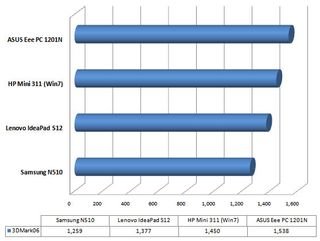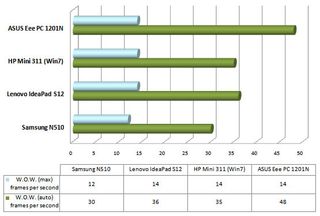Shootout: What's The Best Ion Netbook?

Most people buy netbooks because they're ultra-light, affordable, and offer long battery life. There's just one thing missing: good graphics performance. That's where Nvidia's Ion comes in, a GPU that's paired with Intel's Atom processor to provide a better multimedia experience on mini notebooks. Ion-enabled machines can not only handle mainstream games like World of Warcraft, they can play high-definition video and stream your favorite shows at full screen on sites like Hulu without any stuttering. You can even edit video at a fast clip using programs like vReveal, which allows the GPU to do the heavy lifting instead of the Atom processor.
Unlike traditional 10-inch netbooks, Ion systems feature 11- to 12-inch displays with higher resolutions (1366 x 768) for enjoying high-def content, as well as HDMI ports for outputting video to the big-screen. And they're only a bit heavier than regular netbooks, ranging from 3.2 to 3.4 pounds. Going the Ion route does involve a couple of trade-offs. Windows 7 models are more expensive than their Atom-only counterparts ($399 to $649), and you'll sacrifice some battery life. But if you like the idea of owning a netbook that offers plenty of multimedia muscle, Ion is for you. But which one is best? We've tested four Ion machines -- The HP Mini 311, Lenovo IdeaPad S12, ASUS Eee PC 1201N and Samsung N510 -- and put them through seven grueling rounds to determine a winner.
Round 1: Design and Ergonomics
All four Ion netbooks on the market today are about the same size with 11.6 - 12.1-inch screens. The IdeaPad S12 is the only one under an inch thin, yet manages to be .2 pounds heavier than the rest (which weigh 3.2 pounds). Though the Eee PC 1201N has the largest footprint -- 11.7 x 8.2 x 1.3 inches --the Seashell design keeps it looking svelte.
Aesthetically, most of these netbooks resemble their 10-inch counterparts, the biggest exception being the Mini 311. There HP took advantage of the extra space to give the system a properly-sized touchpad, to correctly position the mouse buttons, and give the keyboard some extra width. Like the IdeaPad S12, the Mini 311 comes with a subtle swirl pattern on the lid (both netbooks are also available with white lids).
Underneath the lid Samsung and Lenovo both went with matte plastic and spare, professional-looking decks. Black, glossy plastic dominates the Eee PC's deck and bezel, which looks great when sitting on a shelf but picks up fingerprints easily. HP's glossy silver deck has the benefit of not betraying finger smudges too much and also lending the netbook a more modern feel.
Each Ion netbook has a near full-size keyboard that offers correct key placement. However, the IdeaPad S12 offered the best typing experience with no flex in the keys and snappy feedback. The keyboard on the Mini 311 comes in a close second.
Stay in the know with Laptop Mag
Get our in-depth reviews, helpful tips, great deals, and the biggest news stories delivered to your inbox.
We also liked the touchpad on the S12 better than the others as there was very little friction, making it easy to slide our finger across it. We also appreciate the dedicated left and right mouse buttons. The buttons on the Mini 311 are larger than the IdeaPad S12's, giving fingers plenty of room. We like the size of the 311's touchpad but wish it had less friction.
ASUS gave the 1201N the Seashell line's dimpled touchpad which has a very distinctive look and is easy to use. But the small single mouse bar beneath it isn't our favorite. The Samsung N510's mouse bar is a bit bigger (but still just one instead of two), and the touchpad is wide and easy to use.
WINNER: HP Mini 311. Although the Lenovo IdeaPad S12 offers a slightly more comfortable tying experience, the Mini 311 blends sleeker looks with solid ergonomics.
- Round 1: Design and Ergonomics
- Round 2: Overall Performance
- Round 3: Overall Graphics Performance
- Round 4: Video Performance
- Round 5: Gaming Performance
- Round 6: Battery Life
- Round 7: Value
- And The Winner Is...
Round 2: Overall Performance
Each of the four Ion netbooks we tested beat the PCMark Vantage netbook average of 1,131. The Mini 311 had the lowest score (1,227) and the Eee PC 1201N had the highest (1,488). This isn’t surprising since the Eee PC has the advantage of a dual-core Atom processor. The next highest score was the IdeaPad S12, earning a solid 1,306.

WINNER: ASUS Eee PC 1201N. All four of the netbooks proved to be snappy performers, but the Eee PC 1201N's dual core CPU helps the machine easily take this round.
Round 3: Graphics Performance
Since netbooks started shipping with bigger screens and larger hard drives, consumers have wanted to use them as portable multimedia machines. And non-Ion netbooks just don't cut it, with video that stutters at full screen, especially Hulu and YouTube content. Ion has changed all that, making it possible to watch both standard and high-definition video smoothly while also handling Flash-heavy websites with ease.
So how much better are Ion machines? The average netbook notches 857 in 3DMark06 (857), a graphics benchmark, and Ion netbooks blow this number away. Once again the Eee PC 1201N led the field with a score of 1,538, but the Mini 311 was less than 100 points behind (1,450). This time the Samsung N510 came in last (1,259) and the IdeaPad S12 was in the middle of the pack.

Most users won’t do heavy video editing or encoding on a netbook, but for the occasional YouTube video or webcam capture, it’s nice to know that you can do some simple encoding on an Ion netbook without having to fix a three-course meal while it’s processing. We transcoded a 114MB MPEG-4 video clip to AVI using vReveal, a program that takes advantage of Ion's graphics acceleration (Nvidia calls this architecture CUDA for developers). The clear winner here was the Mini 311, completing the task in just 4 minutes, 52 seconds. The IdeaPad S12 took the longest at 9 minutes, 30 seconds.

WINNER: HP Mini 311. Taking both 3DMark06 and video transcoding into account, the Mini 311 comes out ahead of the Eee PC 1201N.
- Round 1: Design and Ergonomics
- Round 2: Overall Performance
- Round 3: Overall Graphics Performance
- Round 4: Video Performance
- Round 5: Gaming Performance
- Round 6: Battery Life
- Round 7: Value
- And The Winner Is...
Round 4: Video Performance
The next generation of Adobe Flash Player, version 10.1, offers hardware acceleration for the first time. That means netbooks with an Ion chip can stream YouTube and Hulu videos smoothly at full screen. (Broadcom has announced its own video acceleration chip for netbooks, but we haven't yet had a chance to test it.)
With the beta of Adobe’s Flash Player 10.1 installed, we played the 720p Star Trek HD trailer and a 1080p Nvidia test video at full screen to measure the framerates. All four netbooks averaged 24 frames per second while playing the 720p clip. The real difference came when playing the 1080p clip. Here the Eee PC 1201N outshined the competition, notching a full 30 fps. The Mini 311 and IdeaPad S12 tied at a respectable 22 fps. Surprisingly, only the Samsung N510 couldn't really handle full HD, chugging along at 7 fps.

WINNER: ASUS Eee PC 1201N. Right now there isn’t a lot of streaming HD Flash video content out there, but Ion allows standard-definition Hulu and YouTube videos to stream at a better frame rate, too. The 1201N is the most future-proof of these systems, easily handling all of the video we threw at it (with help from Flash 10.1).
Round 5: Gaming Performance
One of the most fun advantages of putting Ion in a netbook is that it can handle mainstream gaming in something that's portable. We tested several games, including Far Cry 2, World of Warcraft, and Spore. Gameplay on Ion netbooks isn’t going to blow you away, but it’s impressive for the size.
We only did formal testing of Far Cry 2 on the Mini 311 and the IdeaPad S12 and both managed a measly 10 fps at 1024 x 768 (autodetect mode) and 6 fps at the maximum resolution. Clearly, this DirectX 10 title is too graphics intensive for Ion and better suited to heartier rigs.
While playing World of Warcraft we measured the framerates of each netbook. Not surprisingly, the Eee PC 1201N’s more powerful CPU helped push the game to an average framerate of 48 fps in autodetect mode. The Mini 311 and IdeaPad S12 both made decent showings with scores of 35 and 36 fps, respectively. Once again, the Samsung N510 lagged behind, reaching 30 fps. The W.O.W. average for more expensive ultraportable notebooks: 36 fps.
At the maximum resolution, all of the netbooks scored 14 fps (8 fps above the ultraportable average) except for the N510, which brought up the rear again with 12 fps.

WINNER: ASUS Eee PC 1201N. You’ll want the 1201N when you join your raiding party or usher your single-celled organism into space-faring domination.
- Round 1: Design and Ergonomics
- Round 2: Overall Performance
- Round 3: Overall Graphics Performance
- Round 4: Video Performance
- Round 5: Gaming Performance
- Round 6: Battery Life
- Round 7: Value
- And The Winner Is...
Round 6: Battery Life
Systems that have hefty graphics cards often don’t last very long on a charge. When you’re talking a 17-inch, 10+ pound gaming rig, that’s not a big problem. However, long battery life is one of the key selling points of netboos. Take that away and consumers may balk.
On the LAPTOP Battery Test (continuous surfing over Wi-Fi), the Samsung N510 outlasted every other Ion netbook with a runtime of 4 hours and 57 minutes. Right behind it was the Mini 311, lasting just 5 minutes less at 4:52. Both the IdeaPad S12 and the Eee PC 1201N are an hour behind, lasting only 3:56 and 3:53, respectively. This isn’t too surprising for the Eee PC 1201N considering its unique dual-core CPU.

WINNER: Samsung N510. The N510 outlasts them all, though the HP Mini 311 isn’t behind by a significant margin.
Round 7: Value
Now we come to the big question: price. Ion technology, along with bigger display sizes and Windows 7 Premium adds cost to these netbooks. The Windows XP version of the HP Mini 311 has the lowest starting price--$399--but once you configure it with similar specs to the competition the price goes up to $584. The IdeaPad S12 costs the most ($649) and the Samsung N510 isn’t far behind ($599). The most powerful of them all is also the least expensive of them all. The Eee PC 1201N costs just $499.
WINNER -- TIE: ASUS Eee PC 1201N and HP Mini 311. The 1201N clearly offers the most bang for your buck, so long as you can live with less than four hours of endurance. But if you can live with the older Windows XP, the Mini 311 is an equally compelling value at $399.
- Round 1: Design and Ergonomics
- Round 2: Overall Performance
- Round 3: Overall Graphics Performance
- Round 4: Video Performance
- Round 5: Gaming Performance
- Round 6: Battery Life
- Round 7: Value
- And The Winner Is...
And the Winner Is...

Thanks in large part to its dual-core processor, the ASUS Eee PC 1201N won 4 out of 7 rounds, so it's obviously the best choice is your priority is performance. However, you get less than 4 hours of battery life, which could be a turn-off for some. The 1201N also has a narrow singular touchpad button. If you can deal with these tradeoffs, consumers looking for a powerful, fast, and gaming-worthy Ion netbook will be happy to own this netbook. Click here for our full review.

The HP Mini 311 is just as strong a contender, but for different reasons. This is the superior machine when it comes to design and ergonomic comfort, plus it lasts nearly five hours on a charge (and even longer if you get the Windows XP version). And while the Mini 311 doesn't have a dual-core CPU, it scored high in our graphics and video transcoding tests. Click here for the full review.
The bottom line: Get the Eee PC 1201N if you want the fastest netbook, and get the Mini 311 if you want a better mix of graphics power and endurance.
